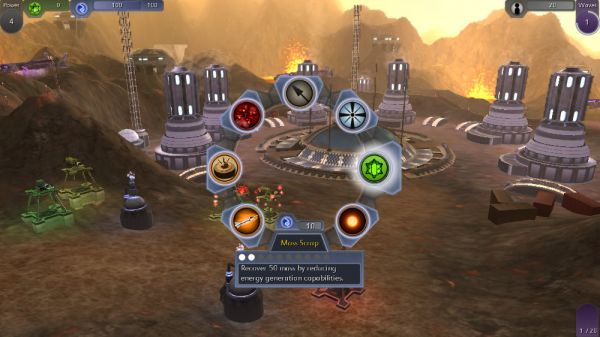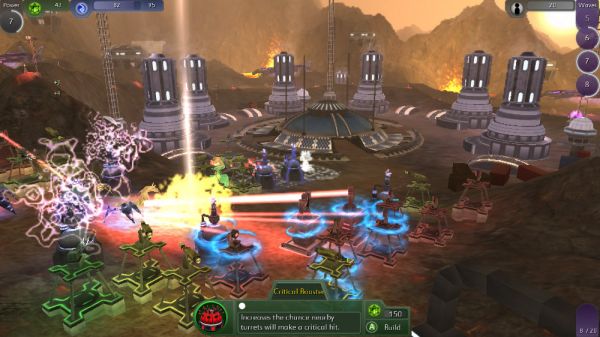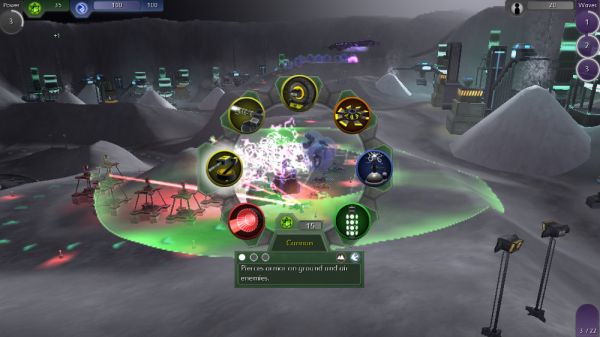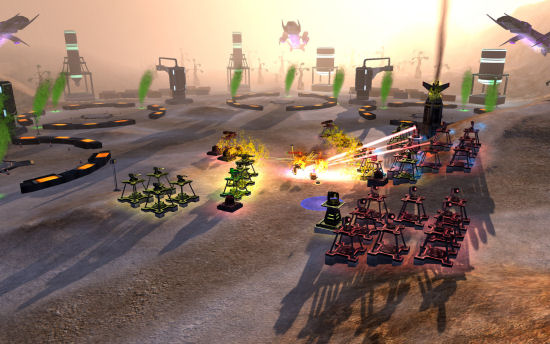As we highlighted in our preview of the title from PAX, Sol Survivor is a tower defense game with a sci-fi feel to it; from the creeps that are protected by force fields to the rail gun and tesla coil turrets. The premise behind the campaign mode (which has a very loose story to connect each of the maps) is that you are a commander with Sol Paragon, an intergalactic military-type organization charged with the task of protecting the colonists and resources of various planets from the evil Ascendancy (the "creeps"). If too many creeps make it from their landing location to the base (or bases, in some maps) that you’re defending, then you lose and have to start the level over.
Throughout the campaign, your commander chooses his Executive Officer (or XO) from a diverse roster of candidates. Each of the 10 XOs has his or her own mix of turrets he or she can build in order to defeat the creeps, as well as a different mix of support functions that are used to aid the turrets in the creeps’ destruction. These support functions, something new to a tower defense game, include such abilities as firing missiles down on advancing foes, hitting them with a firebomb, or dropping a nuke. While most of the support functions fall into the category of pure offense, other functions provide different kinds of assistance like increasing the rate of fire for turrets’ within a particular area, or causing the enemies to turn around and run back for a short period of time. In a genre where that extra bit of firepower and/or time to shoot at something means the difference between victory and defeat, these functions really come in handy. The support abilities, though, are not limitless as each one costs a certain amount of “energy,” a resource that does regenerate over time but not fast enough to provide you with a consistent means of eliminating the creeps; the turrets still do the heavy lifting for that. These abilities, however, do allow for a new kind of co-op for tower defense games, and add a fairly interesting strategic element to a co-op mode that’s been around since the tower defense mods for games like Starcraft and Age of Empires.

A sample of some of the support abilities you have at your disposal
Sol Survivor offers co-op seekers two forms of co-op play: Duo Campaign and Cooperative multiplayer. The Duo Campaign, which is limited to just two players either locally or on-line, splits the responsibility of building turrets and using support abilities between the players and allows them to choose a map from any of the solo campaign maps they wish to play. Even though it’s not a true campaign co-op mode where you progress level by level the same way you do in the solo campaign, there isn’t much of an overarching story that you’d miss out on by jumping straight to the last map. Once you’ve selected your map, players can choose which XO they wish to play. The first player has access to the turrets from the XO they select and the second player uses the support abilities of the XO they select, which means that you can come up with some pretty deadly combinations. Due to the relative strength of some creeps and the amount of damage the support abilities can provide directly, the second player takes on a bit more of a passive role than the player in charge of the turrets, with the occasional last minute save thanks to a well paced gas cloud or missile barrage. This mode serves as a good introduction to the game for any first time tower defense players, and it works well as a fairly casual play experience, but more seasoned tower defense players looking for more of a challenge and a bit more co-op will likely want to skip straight to the Cooperative multiplayer mode.

One player provides support while the other builds the turrets in Duo Campaign
In the Cooperative multiplayer mode, players work together to stave off multiple waves of creeps from entering the base. With the release of the patch last week, there are now three co-op maps for players to choose from: two that support up to three players and one that supports up to four, locally and on-line. After choosing an XO, each player is assigned a certain portion of the map where he is allowed to build his turrets and use his support abilities. Those portions of the map that lead directly into the base are accessible to all players as a kind of "last ditch" effort to try to stop the creeps before they claim an innocent soul. In order to survive the multiple waves of creeps that threaten the well-being of the planet’s residents, players must strategize and coordinate not only the types and locations for their turrets, but when to use their support abilities as well. While players may choose the level of difficulty for each map, each map has also been designed and balanced to its own degree of difficulty, and some of the maps are definitely more challenging than others. This varying difficulty does allow for some replayability as you and your friends try to meet with equal success under different conditions, however most of the replayability comes as a result of a somewhat unfortunate, and unintentional, "learn through trial-and-error" system.
Planning an effective strategy with your co-op partner in this kind of a game depends on three things: knowing your enemy, knowing the tools/resources at your disposal, and knowing the lay of the land. By far, the biggest detractor from the Cooperative multiplayer mode is that none of this information is readily available to you when you’re setting a game up. When choosing a map to play, players can see the name of map, along with a few other options that the host can tweak, but no picture of what the map actually looks like. It is only after players select a map, their XOs, and start the game that they are given a birds-eye view of the terrain and the path the creeps take as they march towards the base; which means that planning a strategy is more akin to an improv exercise than a war room discussion with Patton the first time you play a map. Descriptions of what your XOs’ turrets and support abilities do also can’t be accessed until the game starts, and any details about the creeps has to be gleaned by selecting them as they pass through your territory. Finally, there are some turrets that are more effective against certain creep-types, but there’s no immediately apparent way to tell what’s effective against what. While these factors don’t make the game any less co-operative, they can cause it to be more frustrating, which detracts from the co-op experience as a whole.

Those symbols in the upper left of the info box indicate the turret's capable of attacking ground and air units
The tower defense genre has exploded over the past couple of years thanks in large part to flash-based gaming and the surge of "casual gamers." All of these tower defense games, while occasionally contributing something new or doing something a little bit different, often feel exactly the same. Sol Survivor avoids this trap with the introduction of support abilities, and two co-op modes that reward strategizing and teamwork. While Sol Survivor is not a perfect co-op title, the co-op elements that it does have work well for the hardcore and casual gamer alike, and are what bring this game above many others.

The Co-Op Experience: One person builds, the other person rains fiery death from the sky in the Duo Campaign mode; or team up with up to 3 of your friends to take on ever increasingly difficult wave of creeps in the Cooperative multiplayer mode.
Co-Op Score: 4
General Score: 3.5
Note: Sol Survivor is available on the Xbox Indie Games Channel on Xbox Live
